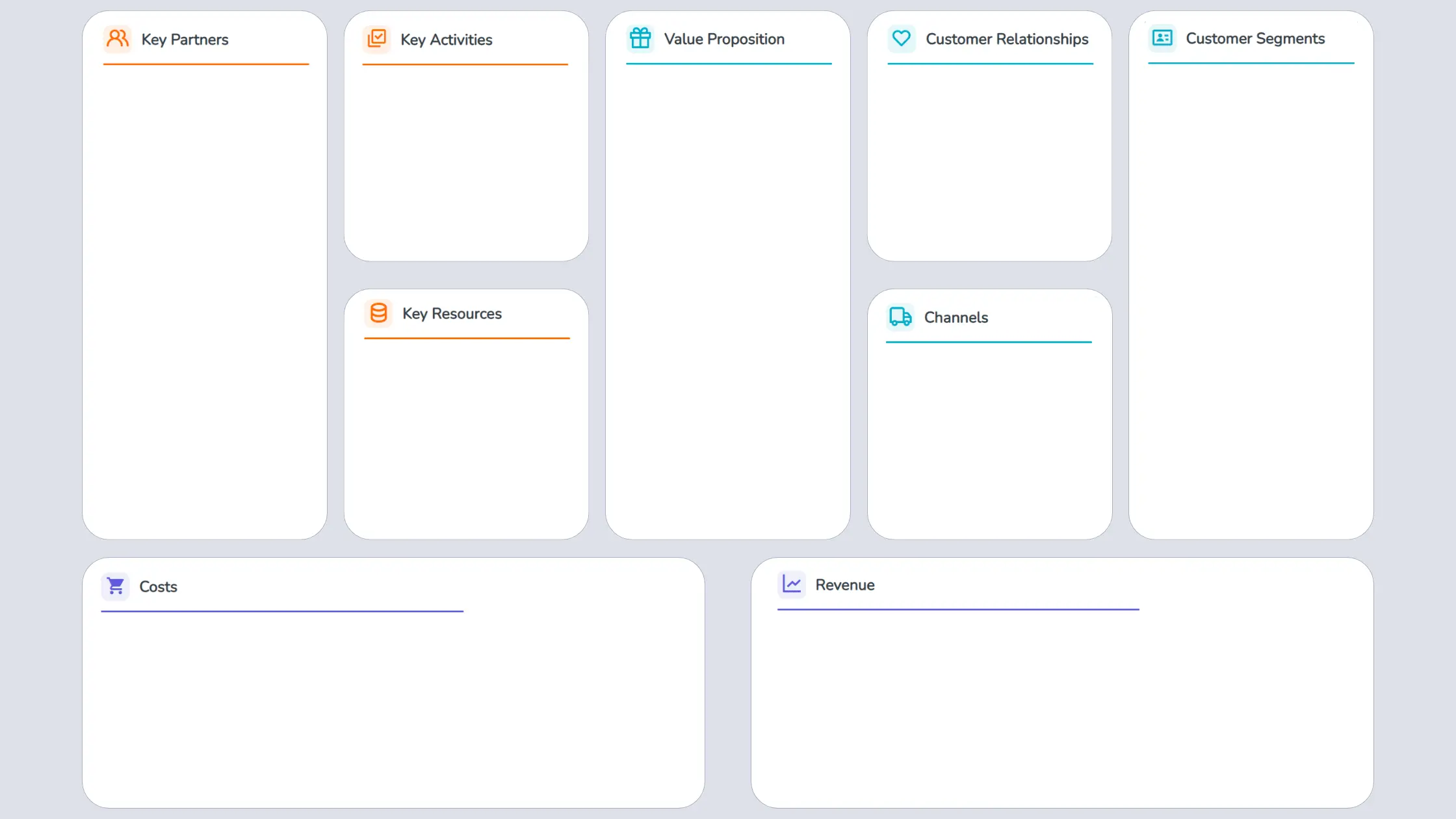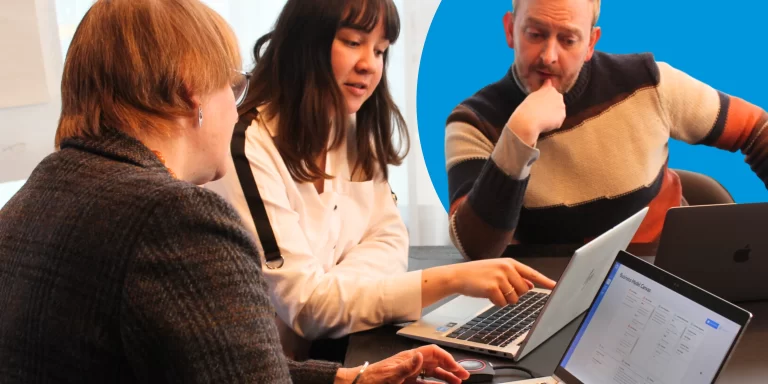What is a Business Model Canvas?

The Business Model Canvas (BMC), created by Alexander Osterwalder, is an easy-to-read one-page template that allows you to visualise business models by breaking them down into nine building blocks.
This strategic management tool simplifies the process of developing new business models and mapping out existing ones. It’s also a hugely popular resource among our clients in Higher Education who teach business and entrepreneurship.
Whether you’re mapping out an existing business model or developing a new idea, the BMC will help. By using the Business Model Canvas, you’ll better understand the key components of a business at any point in time.

What are the Business Model Canvas building blocks?
There are nine blocks that make up the Business Model Canvas. In no particular order, these blocks are:
- Customer segments
- Value proposition
- Channels
- Customer relationships
- Revenue streams
- Key resources
- Key activities
- Key partnerships
- Cost structure
These nine elements provide the framework for developing a comprehensive business model. As such, they also allow you to identify, analyse and evaluate potential business opportunities.
What do each of the BMC blocks mean?
So you’re able to fill in your own BMC (or show someone else how to!), let’s dive into what each of the building blocks of the canvas mean.
Please note, these blocks below are not in any particular order – you can start from whichever block you prefer. If you are looking for some direction however, the two most common starting places we’ve seen in our online business validation platform, Validate, are: ‘Value Proposition’ or ‘Customer Segments’. The important thing to remember is that all blocks should interlink in some way, for example your value proposition should be attractive to your customer segments.
Now, let’s dive in!
Customer segments
This section is all about identifying who your customers are. The customer segments section of the Business Model Canvas is where you would write the specific groups of people that the business is targeting with its products and services. This could include demographics such as age, gender, and location, or even psychographics such as interests and lifestyle.
Value proposition
The Value Proposition section is in the middle at the top of the BMC. This section asks you to consider the unique value that the business is providing to the customer segments. It is also the reason why customers should choose the business over its competitors. This could include unique products or services, better prices, superior customer service, or any other factor that sets the business apart from the competition.
Channels
Channels is a smaller section between customer segments and the value proposition on the Business Model Canvas. This section should outline the communication methods the business is going to use in order to reach and interact with its customers. Channels could include physical locations, websites, social media, and other methods of communication.
Customer relationships
The customer relationships component sits right above the Channels section of the BMC and refers to the different types of relationships the business will have with its customers. By considering how you will build relationships with your customers and maintain those relationships, the business will have a better chance of success. Examples of the types of relationships are: transactional, long-term, self service, automated, and personal.
Revenue streams
Revenue streams sits at the bottom of the Business Model Canvas and should include all the ways in which the business earns money. This could include sales of products and services, advertising, subscriptions, or any other source of income.
Key resources
Key resources sit to the left of the value proposition within the Business Model Canvas. This section is all about what you need to create and deliver the products and services of the business – this includes the physical, financial, and human resources you need. Examples include things like office or factory space, employees or contractors with specialist skills, and IT equipment.
Key activities
What steps does the business need to take in order to deliver the value proposition to the customer segments? This is the question the key activities section asks you to answer within the Business Model Canvas. By identifying the tasks that must be performed in order to produce and deliver the products and services to your customers, you’ll be better prepared to operate the business. This section sits directly above key resources within the Business Model Canvas template.
Key partners
The key partners section sits on the opposite side of the Business Model Canvas to the customer segments. This is the section within the Business Model Canvas where you need to consider the outside organisations and individuals that the business relies on to help it achieve its goals. This could include suppliers, distributors, and other businesses.
Cost structure
Situated along the bottom line of the Business Model Canvas right next to the revenue component is ‘Cost structure’. The cost structure component of the BMC covers the expenses associated with running the business. This could include personnel, rent, and materials.
What can you use the Business Model Canvas for?
The Business Model Canvas has many applications, and we’ve seen it used a lot in business and entrepreneurship education around the world. Some of the common ways the BMC can be used are:
- Visualising business models of existing or brand new businesses
- Planning, communicating and testing startup ideas
- Mapping out existing businesses to understand how they operate
- Analysing business models (existing or brand new) in order to identify areas for improvement
- Determining how a new product or service might be introduced to an existing business
While the BMC is a highly popular tool used for teaching business, entrepreneurship and enterprise, it is also very useful for entrepreneurs and professionals to effectively plan and execute a successful business strategy. Let’s look at how the BMC might help an aspiring entrepreneur validate a business model before launching their startup.
How to validate a business model with a BMC
While the Business Model Canvas was developed as a simple and easy tool to use, it can be helpful to look at the BMC template through a design thinking lens.
As explained by IDEO, Design Thinking brings together “what is desirable from a human point of view with what is technologically feasible and economically viable”.
Similarly, the three components – feasibility, viability and desirability – are required in order for a business model to be successful.
As such, the Business Model Canvas can also be grouped into these three areas as shown in the below image.

The left-hand side of the Business Model Canvas covers feasibility of the business. This area of the BMC template includes key partners, key activities, and key resources.
The right side of the Business Model Canvas covers the desirability of the business, which is essentially all of the customer-focused sections. The BMC components include the value proposition, customer segments, channels, and customer relationships.
Lastly, the bottom of the BMC template consists of the costs and revenue, which is linked to the viability of the business model.
While, the Business Model Canvas can help you to consider these three factors – desirability, viability, and feasibility – ultimately, a completed BMC (in particular for a brand new startup idea) will be based on a series of assumptions. Therefore, to ensure the business model is valid, it is vital to identify and test these assumptions.
Still need help?
We hope this post has helped build your understanding of the Business Model Canvas, however if you are still feeling a little stuck, we highly recommend taking a look at our online entrepreneurial tool, Validate.
Validate supports educators to teach the Business Model Canvas, along with identifying and testing assumptions to students in an engaging and meaningful way. It is also available to individuals who would like to ideate, plan, and test their own business ideas.
With SimVenture Validate by your side, you’ll understand the components of a Business Model Canvas in no time!
-
Validate 2023 release
Discover the highly sought-after Validate features that will be hitting your screens in September 2023.
-
Business Startup | Entrepreneurship Education | Online Learning | SimVenture Classic | SimVenture Evolution | SimVenture Validate | Startup Support | Uncategorized
How to turn an entrepreneurial idea into a tangible business
Starting a business is never an easy feat and in Mohammed’s case it is a journey filled with many entrepreneurial ideas and learning experiences. From a young age, Mohammed Ali was always brimming with ideas and the launch of his first business was just the starting point of his entrepreneurial journey. Years later, the entrepreneur…
-
Competition | Entrepreneurship Education | Online Learning | Opportunities | SimVenture Evolution | SimVenture Validate | Technology in Higher Education
Do student competitions truly motivate learners?
Do student competitions motivate learners? There are advantages and disadvantages but what effect do these competitions have on students?




